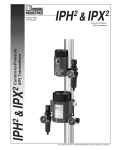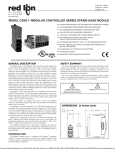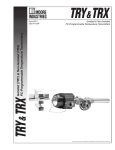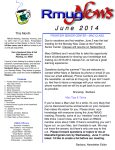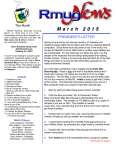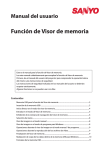Download Paper - BSC Engineering
Transcript
Industrial Ethernet Brad Stephen Carlberg, P.E. Control Systems Engineer BSC Engineering Richland, WA (251) 454-1200 [email protected] Jim McConahay, P.E. Sr. Field Applications Engineer Moore Industries-International, Inc. North Hills, CA (818) 894-7111, ext. 320 [email protected] Abstract Industrial Ethernet is becoming a de facto, and open, standard for control system network communications. Controllers and instruments can communicate with each other via MODBUS, Ethernet and via OPC making tag databases and real-time process data available anywhere there is a connection to the Ethernet. Many instrument and control vendors offer modular, Ethernet I/O systems that can be used as a relatively low-cost method to bring information from plant field devices into a computer, SCADA, or control system using Ethernet. Able to be quickly configured, they communicate with one another, as well as with other computers over standard Ethernet using off-the-shelf Ethernet hubs, switches, and/or routers. Then, data acquisition and control data can be viewed from a browser, a spreadsheet, or a third-party HMI package. Keywords 802.3, CIP (Common Industrial Protocol), COM, DCOM, Ethernet hubs, Ethernet IP, Ethernet router, Ethernet switch, Ethernet/IP, Fieldbus Interface Module (FIM), Foundation Fieldbus, FTP, HMI, HMI (Human Machine Interface), HSE (High Speed Ethernet), HTTP, I/O systems, IEC 61131, Modbus, Modbus RTU, Modbus TCP, ODVA (Open DeviceNet Vendor Association), OPC (OLE for Process Control), OSI (Open System Interconnect), PAC, PLC, PPP, Profibus PA, Protocol Converter, RJ45, SCADA, SMTP, SNMP, TCP, TCP/IP frames, TCPIP, UDP, VPN, WAN Introduction Electronic communications from one instrument to the next is rapidly becoming requisite best engineering practice in the design and upgrade of any industrial sites. In the past, it was acceptable for sensors, valves, machines and processes to perform their routine tasks with only occasional settings updates and maintenance by multiple process operators and/or technicians each carrying clip boards. This is no longer practical and economical for the efficiencies required by today’s industry. The rapid emergence of international manufacturers that use the latest in modern technology and low labor costs is rapidly antiquating earlier designs, processes and instrumentation approaches. Further, increased awareness of safety, profit point and real time monitoring required to ‘tweak’ the greatest productivity at lowest cost and least risk to personnel, the environment and the stockholders is further pushing the performancepeaking requirements of virtually every industrial facility. To achieve this improvement to be competitive and peak in profitability, we now need to redesign our processes and adapt. The most successful method is to review our current process method and compare it with the latest methodology—then adapt. All new facilities need to be designed from the ground up to compete with offshore competitors. Existing facilities need to progressively upgrade. If well planned, the increase in productivity and profitability will promptly pay for the improvements at each step. If it is a municipality, there may be little competition from abroad. However, the real need is the same for increased productivity in the face of diminished taxpayer funds and the need to minimize the installed cost to customers for the product. Distributed with permission of author(s) by ISA 2010 Presented at ISA Automation Week 2010; http://www.isa.org To assist us today, we have modern instruments with built-in intelligence that perform single (or multiple) tasks, have integral communication ports (Ethernet, serial, fiber optic, wireless, etc.) and use open sourced communications protocols (MODBUS TCP, MODBUS RTU, HART, FOUNDATION Fieldbus, PROFIBUS PA, OPC, HSE, Profinet, CIP, to name a few). Modbus/TCP, an open protocol in which Modbus packets are encapsulated in TCP/IP frames, is used because Modbus is widely known and supported worldwide. OPC, OLE for Process Control, uses Microsoft’s COM/DCOM/.NET standards for open comm. OPC can run over any physical medium and is an open, free of charge protocol that both hardware vendors and software vendors have access to. Many supported development tools. OPC has a strong backing by the OPC Foundation. HSE, High Speed Ethernet, is a Foundation Fieldbus protocol, runs over Ethernet and is an open protocol, and has a large organized support base by both vendors and the Foundation Fieldbus Organization. Profinet is the Profibus Trade Organization’s answer to open communications. It is NOT Profibus over Ethernet!!! Reason: Strong backing by PTO. Can use 802.3 layer, but not restricted to this layer, and can run over modems, WAN’s, VPN’s, as long as it uses TCP/IP addressing. CIP, Common Industrial Protocol, is being promoted by ODVA (Open Device Vendors Association) uses a Producer consumer network philosophy for real time control applications. With IP (and TCP or UDP), the use of Ethernet among other technologies such as wireless or PPP works. Same at the top many protocols are available based on the task that needs to be done. Better yet, those application protocols can be used simultaneously. Many of these communications protocols have built-in error reporting, and self-diagnostics for use as a preventive warning prior to performance degradation. In the case of valves, some include internal routines to verify responsiveness as to actual positioning. There is a select group of instruments specifically designed for the highest reliability to be used in key safety related positions, complete with appropriate SIL certifications. When modernizing industrial designs for profitability and safety, we will want to replace earlier vintage instruments, controls and methodology to capitalize on the significant advantages of these modern instruments, valves, alarms, and communications. The key to success is to use the best sensor, valve, PLC, and communications methods in each respective area. To achieve this optimization it is paramount that all of these products use popular open-architecture protocol and popular, standardized communications. In the past, various products from different manufacturers used proprietary protocols or communications methods such that the best sensor required special processing (conditioning, hardware and/or software) before it could be married with other system data. This led to many large systems using products from sensors to valves, to host computers and application software, from one of the big firms. Let us take a look at how this earlier hurdle is now being reduced in magnitude by today’s industrial manufacturers. The OSI (Open System Interconnect) Model (Figure 1) identifies the various layers necessary for a freshly captured temperature sensor signal to be processed on the Application Layer Level 7 and then progressively ‘handled’ by software, firmware and hardware until it exits out the bottom onto the Physical layer1 RJ45 Ethernet cable connector on the an Ethernet cable. When the data is collected by another instrument or host computer, it would travel upwards through the seven layer pathway. However, since this second device was ‘different’, it required some similar and some different additional extensive engineering again. To be sure, it was very convenient for the system designer to throw up his/her hands and concede to having one manufacturer provide all of the system instruments, and communications and application programming just to avoid even attempting such a ‘compatibility terror’. Distributed with permission of author(s) by ISA 2010 Presented at ISA Automation Week 2010; http://www.isa.org Figure 1. Open Systems Interconnect Model Simplified. The popular Ethernet 802.3x standard uses this same seven layer approach. Ethernet that ‘we’ see as designers involves physical hardware (RJ45 connectors, Ethernet LAN cables, LAN switches, routers, and gateways) and some indicator LEDs. It also requires us to set a few communications addresses. The intermediate addressing and formal communications protocols (and their associated timing, retries, error corrections, etc. to assure good quality communications) are transparent to us. The uppermost layer of the OSI is data and our own application program that routinely works with this data. In the past, there was a major hurdle of inter-vendor compatibility. This impediment is now essentially gone. We can now frequently use sensors, instruments and control elements from many different vendors. Setup for the instruments for communications and data compatibility are greatly simplified. Essentially no engineering time is invested in the details of middle portions of the 7 layer OSI model. The designer may now use the optimum device in each application, with this advantage realized several times in the overall plant instrumentation strategy. Note that multiple vendors may manufacture a similar type of product with similar communications and data protocol. The OSI model does not imply that these are ‘drop-in’ replacements for each other. However, for similar products, it is likely that many of the same features are available. This simplifies the design architecture of any system by permitting a variety of suitable products to be connected at each location. Open connectivity is desirable so that the hardware (cables and connectors) and protocols (OPC, HTTP, MODBUS TCP, MODBUS RTU, Ethernet IP, FTP, FOUNDATION Fieldbus, PROFIBUS PA, etc.) that interconnect your overall system can communicate. This may be sensor-to-valve, sensor-to-multiplexer, sensor-to-host computer, etc. Open connectivity enables us to work more freely to collect input data, process data, and provide output to controls and HMI (Human Machine Interface) panels. As designers, we are being paid great sums of money to concentrate on the details of optimizing the process for our customers. We want to select vendors that provide universal products that provide for simple communication of process and control data, and most important, communicate seamlessly with one another. Distributed with permission of author(s) by ISA 2010 Presented at ISA Automation Week 2010; http://www.isa.org The opposite of ‘open connectivity’ is ‘proprietary’. Proprietary is fine for unique applications where no other vendor product can provide the extra level of precision or other parameters critical to the task. We pay a premium since proprietary requires the customer engineer to invest extra dollars for special communications, unique setups, and custom data conversion algorithms to make the proprietary data be able to interact with the rest of the system. There is no ‘ideal’ communications media. Twisted pair, fiber optic, wireless and Ethernet each has its merits. Each is found in virtually every facility. Each has advantages of cost, speed, plant wiring infrastructure, data switching, and power to instruments and actuators. No one media or protocol solution should be forced onto a given site. We should design for the optimized communications media and protocol for the application. So what if our ideal communications and protocols for one area of the plant do not match? Introduce the Protocol Converter – also known as a ‘gateway’. A gateway is both hardware and firmware. It has two interface ports plus a shared memory in one overall package. One interface may, for example, be Ethernet compatible. All communications to/from this port are ‘seen’ as Ethernet. The designer may need to specify an Ethernet IP address and perhaps little more. The second interface port may, for example, be fiber optic. Minor configuration, if any, is required on the fiber optic port. A fast microprocessor (or pair of microprocessors) handle(s) the OSI model tasks. Data is temporarily stored within the internal memory until it is required on the ‘other side’ of the gateway. A communications user on one side of the gateway is usually not aware it is communicating with a different communications media/protocol. When communicating data from the field to the host and onwards to control functions, it is usually multiplexed. Multiplexing enables many channels of data to be ‘digitized and then sent as ‘incorruptible’ data packets to the host computer or other site. By ‘incorruptible’ is meant that the OSI model firmware/hardware automatically enables the Ethernet link to communicate via digital data packets (not analog). Ethernet has a major advantage over other communications media since it is capable of handling a tremendous amount of data (>10+ Mbits/second). When collecting data from individual sensors, the multiplexer also needs to isolate the data signal levels from each other to prevent data corruption including ground loops and common mode signals. Setup for each channel can be on block level (all the same setups) or channel-by-channel (preferred). At the ‘other’ end of the communications link may be the host computer. By retaining the Ethernet communicated digital packets in digital format on the full length of the Ethernet cable; there is no loss of resolution/accuracy of the original signal data. Some legacy host computers may only accept analog input signals. If so, an Ethernet based demultiplexer is used to re-create the signals from their digital packets back into analog voltage or current signals. There is a slight loss of data resolution at this D/A interface immediately followed by the host computer own A/D. Consider the cost savings and complexity reduction by replacing costly legacy A/D (and D/A) I/O cards with a single Ethernet I/O card on the host computer. Signal pathways in legacy systems, such as 4-20 mA current loops, are single direction. Ethernet and other digital communication systems share the cable pathway permitting communications in both directions. The advantage is reducing cable count immediately. The OSI model incorporated into the electronics of sensors, actuators and other communications equipment automatically handles the Ethernet communication signal timing, handshakes, data collisions, resends and verification of data integrity. It is not a single pathway. There are multiple methods to route the Ethernet cables throughout the facility. A simple Peer-to-Host computer cable path connects a single sensor (or multiplexer) to the host computer. A Peer-to-Peer cable pathway allows devices to communicate with other devices without the need for a host computer. There is sufficient addressing in the participating devices to provide the timing and direction of data transfers. An example of Peer-to-Peer is a flow meter communicating to an intelligent Distributed with permission of author(s) by ISA 2010 Presented at ISA Automation Week 2010; http://www.isa.org valve actuator. Another is a single or group of instruments connected to an HMI (Human Machine Interface) panel. The Ethernet communications link may also be a Hybrid interconnection. This is a combination of Peerto-Peer plus Peer-to-Host cable pathways. This enables communications throughout the facility in the most effective manner. Ethernet cable connections are effected via Ethernet LAN switches. The LAN switch is a microprocessor based piece of hardware and firmware that ‘regenerates’ Ethernet signals for extending communications ranges. LAN switches also provide selective data routing of data packets onto only desired cable paths so ‘unnecessary’ data packets are not repeated onto all other cable paths. LAN switches also provide security (user configurable) to prevent unauthorized users from ‘sharing’ the data packet stream. A VPN (Virtual Private Network) consisting of front office network computer, another VPN consisting of Production control room computers and a third consisting of selective ‘off-site’ uses IP addresses and security password. Such precautions are intended to keep all Production activities away from the curious eyes and fingers of unauthorized personnel, yet facilitate control and monitoring of all facility activities. A facility with thousands of 4-20 mA current loops may be multiplexed onto a single Ethernet cable with actual improvement in data transfer speed, resolution and accuracy. 9 Case Study #1 – FOUNDATION Fieldbus Transmitters into Programmable Automation Controller Problem: A client wanted to monitor and control the fluid flow of a process containing several FOUNDATION Fieldbus flow, pressure, and level transmitters and variable-frequency drives on pumps with a Programmable Automation Controller (PAC). The PAC communicated with the variable-frequency drives via a DeviceNet card in the PAC backplane, but could not communicate with the FOUNDATION Fieldbus transmitters since they couldn’t communicate via MODBUS TCP and an Ethernet TCP/IP card in the PAC backplane. Solution: A MODBUS TCP-to-Ethernet TCP/IP protocol converter1,2 and a managed Ethernet switch were installed between the FOUNDATION Fieldbus Interface Module (FIM) 3 and the PAC. The MODBUS IP registers for each of the process variables for the FOUNDATION Fieldbus transmitters were mapped in the FIM using browser-based configuration software. Then, corresponding global tagnames were built for each transmitter in the PAC with its configuration software. Next, all three devices, the FIM, the protocol converter, and the PAC, were connected to the managed switch. Finally, the protocol converter was configured in an object-oriented configuration language to connect the FIM with the PAC. Figure 2. Protocol converters provide interface between devices that use dissimilar communication methods. Distributed with permission of author(s) by ISA 2010 Presented at ISA Automation Week 2010; http://www.isa.org Protocol Converter Converts Modbus TCP to Ethernet IP FT PT Foundation Fieldbus Interface Module Modbus TCP FOUNDATION Fieldbus H1 Managed Ethernet Switch FIM Ethernet IP LT FT FOUNDATION Fieldbus Transmitters Local HMI Display Ethernet IP PT LT Programmable Automation Controller (PAC) Case Study #2 – Remote ESD (Emergency Shutdown Device) for Oil Production Platform Problem: ENI Petroleum is the operator of an oil well production platform located just off the coast of Louisiana. Part of their operation involves the use of long undersea pipelines plus occasional maintenance ships that perform repair and other services in close proximity to their pipelines. For safety, the Mineral Management Services (MMS) has notified the platform owner that a direct, real time communications link needs to be installed and a plan in place should any wells be affected by a possible event such as a ‘dropped object’ in the vicinity of a submerged pipeline. Further, the communications link needs to be proven reliable with a verification method. Wells and pipelines need to be shut down (production stopped) should a potential hazard to the pipeline occur or if communications is lost. To comply with this directive, ENI has been using short range radio links – one in their control room with the other on the maintenance boat. Now ENI is starting pipeline work which will expand to a distance of greater than 100 km from the platform. Normal radios are not reliable for this ‘over the horizon’ required communications link. Considerations: Communications solution must accommodate any transmission distance, even >100 km. Reliable communications with built-in verification and security. Two-way voice radios are not appropriate to meet MMC requirements. Simple HMI, automatic, zero to near-zero learning curve. Suitable for use on platforms as well as on any maintenance ships. Installs readily with existing control room electronics on platform and on maintenance ship. Solution: The conversation initiating EMI’s requirement was via telephone – VoIP (Voice over Internet Protocol). This technology compresses voice messages into packets to fit on an Ethernet network. The oil platform uses Ethernet communications for their telephone, emails, weather, internet surfing, and communications Distributed with permission of author(s) by ISA 2010 Presented at ISA Automation Week 2010; http://www.isa.org with the mainland. The Ethernet cabling is readily available in the control room and critical areas of the platform. The maintenance boat is large enough that it also uses satellite communications for the same important tasks. The system consisted of a simple NET Concentrator System (NCS) data concentrator hardware system that mounts on DIN rails. The data concentrator system consists of two EIM (Ethernet Communications Modules). The first EIM is matched with a Discrete Input Module (DIM), and is mounted in the Ship Control Room. The second EIM is matched with a Relay Output Module (ROM) mounted in the Oil Platform Control Room. The control programs run on the kernel level of the data concentrator. Two data concentrator hardware systems are assembled. Communications in-between the two data concentrator systems are via Ethernet cable. Addressing is via IP addresses. The system used a IEC 61131-compliant (with the five standard languages; ladder, function blocks, structured text, sequential function charts, and instruction lists) software configuration program 4 to set up the two data concentrator systems to collect contact switch input signals, timers and communicate backand forth with each other. EMI then developed their own application software to scan the input switch contacts and combine these into digital memory locations. The data concentrator’s EIM module then converted these contact closures and packaged them for transfer via Ethernet cable to the other data concentrator. At this second data concentrator the Ethernet data was disassembled and placed into variables and memory locations to activate relay contact closures, as required. A contact closure at one data concentrator activates a relay on the second data concentrator. Thus a one-way communication was established. Each data concentrator has a unique IP address. The EIM internal Ethernet communications addressed and directed all levels of the OSI stack so the programmer only needed to provide ‘correct’ addressing, the EIM handled all communications protocol, retries, collisions, dropouts, etc. The maintenance boat data concentrator has a mechanically latching pushbutton switch. The oil platform data concentrator has a klaxon horn plus a set of contact closures connected to the control panel wired in failsafe mode. During normal operation of the data concentrator provides operator visual indication, audible alarm (klaxon), and electrical signal connections to the control room panel. The MMS directive also requires a reliable communication. We need to verify there is continuous communications back-and-forth between the two data concentrators. If not, then a ‘communications’ alarm is automatically initiated. Normal communications are set up for bi-directional updates of all data within each data concentrator every one second. A ‘watchdog’ subroutine is added to each data concentrator. If a successful communication is received from the other data concentrator, then the watchdog timer is restarted and a green color ‘communication status’ lamp is illuminated for this data concentrator. Should several communications dropouts occur, then the watchdog timer times-out and the ‘communications status’ changes color, and a separate set of contacts is sent to the control panel. Should further watchdog time delay occur, then another set of contacts is closed and sent to the control panel signaling end of grace period for down communications. The system successfully tested well on the bench. The data concentrator was secured via password protection. Next, the Ethernet ‘port’ assignments needed to be activated to communicate all data via the Ethernet cable. This information was forwarded to the satellite link Internet providers. The ports were opened for bi-directional access between the two data concentrators. It was also opened for the laptop used by the service technicians so the technicians could monitor any activity between the two data concentrator by tapping into the Ethernet cable at select locations on the oil platform and also on the Maintenance ship. The satellite link and on-board Ethernet technicians thus provided added security that this critical information was protected from be ‘shared’ by any unauthorized Ethernet visitors. Upon activation of the data concentrator system, both data concentrators were powered up. Within one minute, the ‘communications’ lamps on both data concentrator were glowing green color as they should. The technician on the maintenance ship announced he was pressing the ‘alarm’ button. About one second Distributed with permission of author(s) by ISA 2010 Presented at ISA Automation Week 2010; http://www.isa.org later, the klaxon was heard from the oil platform control room via the telephone. The alarm was successful. The alarm switch was cleared and the klaxon immediately silenced. Next, to simulate a communications fault, the Ethernet cable was removed from one of the data concentrators. After a few seconds, the ‘communications’ alarms simultaneously activated on both oil platform and maintenance ship. Upon reconnecting the cable, the communications were successfully restored at both sites within about one second. The data concentrator system meets MMS directive for reliable communications for this safety task. The system is put into service ‘on schedule’. The system remains in service and is reliable for all activities, and proves to meet all expectations. When severe weather briefly obstructs the satellite communications link, the data concentrator briefly also goes off line with its appropriate signaling lamps. Upon satellite link restoration, the data concentrator remote ESD recovers immediately. Further application: Due to the reliability and simplicity of the data concentrator system, ENI engineers have decided to add telemetry capability to each data concentrator. The telemetry is bi-directional. By merely adding a DB25 cable to each data concentrator, ENI is able to add up to 14 additional I/O (Input/Output) data concentrator plug-in modules for transferring digitized analog and discrete signals (temperature, pressure, flow) and even feedback control signals. Since the Ethernet packet is burst in just a few hundreds of microseconds for each data concentrator, there is plenty of extra time available for the added telemetry—on a non-interference basis. ENI now has a powerful communications method to operate safely at any communications range. Distributed with permission of author(s) by ISA 2010 Presented at ISA Automation Week 2010; http://www.isa.org Figure 3. Two-way communications via Ethernet and satellite. Case Study #3: Wireless HART and 4-20 mA Loops for Use at Multiple Sites Problem: An asphalt plant in the mid-west is expanding. This involves upgrading its sensors and communications links throughout their facility. Some control loop tasks were originally performed only locally. Other tasks were under the control of a host computer. Now tasks are to be simultaneously controlled, monitored or updated from the central host computer. There are not enough of the original 420 current loop communications links to handle all of the sensors and control pathways. Considerations: Use existing cable runs (4-20 mA current loop cables) when practical to save money Use fiber optic cable for long distance Multiple contractors and vendors involved Allow flexibilities for future growth as additional parts of the facility are upgraded Be compatible with host computer – MODBUS plus I/O channels Solution: There is no one solution. Site #1: One application uses multiple 4-20 mA sensors via a large multi-pair cable. Customer seeks additional 420 mA channels now, but is no budget to run any new cable. However, when a future portion of the facility grows, then an Ethernet or fiber optic cable will be installed. Distributed with permission of author(s) by ISA 2010 Presented at ISA Automation Week 2010; http://www.isa.org A data concentrator is installed at each end of the existing 4-20 mA cable in a Peer-to-Peer network. Each data concentrator consists of up to 16 analog I/O modules thereby supporting scanning up to 64 input or output channels. Added to each data concentrator is an MIM (Modbus Interface Module) that communicates MODBUS RTU communications over RS485 twisted pair. By borrowing one pair of wires from the 4-20 cable bundle, the customer now has 64 channels of analog data being transferred on only one pair. After this initial success, the customer realizes that the multiple data concentrator systems—not just one pair—may be set up at each end of this same twisted pair cable, thereby providing hundreds of channels communicating on the original twisted pair. As future growth occurs and an Ethernet LAN capability is brought to these sites, then the data concentrator’s MIM modules may be removed and replaced by EIM (Ethernet Interface Modules). Connection is removed from the twisted pair and placed onto an n Ethernet LAN cable. A simple IEC 61131-compliant software configuration program is written to transfer data back-and-forth amongst the various data concentrators. Figure 4. Data concentrator in a Peer-to-Peer network. Thus the customer receives an immediate growth capability without laying new cables. This may be expanded by adding I/O modules and even additional data concentrator systems. Finally as Ethernet cables are made available in the future, the data concentrator communications MIM modules are swapped with EIM modules for communications media upgrade. Negligible waste is incurred in this process. Site #2 A tank farm application collects sensor data from multiple sources. It is not economical to run cables. However, nearby it is necessary to collect this data, convert to readability by an HMI panel and also communicate it to the host computer in the Control Room via a fiber optic communications link. Tank farm data is collected via wireless HART using a Wireless Gateway5. Sensor data is collected from the wireless link and stored in registers within the gateway. A MODBUS data concentrator 8 has both MODBUS RTU and MODBUS TCP ports. The gateway is wired via its Modbus RTU serial port to one of the MODBUS data concentrator serial ports. A ‘Scheduler’ text file is loaded into the MODBUS data concentrator to enable it to operate as a MODBUS RTU master, thereby extracting selected HART data from the gateway. Now that the data is being automatically transferred into the MODBUS data concentrator, an IEC 61131compliant software configuration program is loaded into the data concentrator to massage the raw HART data into human readable form (scaling, binary to decimal conversion, etc.) and organizing for display on a local HMI panel. Tank farm data is now usable for humans. The MODBUS data concentrator can also Distributed with permission of author(s) by ISA 2010 Presented at ISA Automation Week 2010; http://www.isa.org use this same collected data to perform control loop functions with sensors and corresponding valves, thereby offloading some tasks from previously being controlled by the host computer. The MODBUS data concentrator also includes an Ethernet port that communicates via MODBUS TCP. The MODBUS data concentrator Ethernet communications cable is connected to an Ethernet-to-fiber optic protocol converter6. This fiber optic converter operates transparently from Ethernet-to-fiber optic and then back to Ethernet. Fiber optic is preferred when the Ethernet signal needs to be linked from one building to another on the same facility. Figure 5. A MODBUS RTU data concentrator expands the number of signals that can be collected and transmitted back to the control room. At this facility, the customer has multiple requirements, multiple time tables for upgrade levels and tight constraints on budgets. Protocol converters bring the applications from dedicated twisted pairs for single channel activities to a growth path providing progressively more and more data per cable. This customer facility is adapting with progressive improvements to meet his/her interim budget and goals, without waste along the way. Conclusions: Thanks to rapid technology improvements, we are now able to optimize the best available sensors, controls and communications links to meet our own particular process needs. We do not need to ‘stay with one vendor’ for all of our process needs. The protocol converters mentioned in this paper emphasize the use of Ethernet-based conversion throughout due to vendor’s implementation of Ethernet and its Distributed with permission of author(s) by ISA 2010 Presented at ISA Automation Week 2010; http://www.isa.org inherent OSI stack. Custom driver designs are now ‘built-in’ to the instruments and the protocol converters thereby virtually eliminating compatibility issues. Design engineers only need to be concerned about their own application (top level of the OSI model) and the electrical connections such as IP addressing and RJ45 connections (bottom level of OSI model). Successful vendors are integrating this flexibility when possible. This viable flexibility enables us to now have a ‘competitive advantage’ in designing and revitalizing our own manufacturing processes. After reading these pages, the reader should have learned at least these three main points about Ethernet I/O: that Industrial Ethernet is becoming a de facto, and open, standard for control system network communications how Ethernet I/O systems can be used as a relatively low-cost method of bringing field devices from your plant into a computer, SCADA, or control system using the Ethernet how these systems can be configured quickly and communicate with each other AND other computers over standard Ethernet using off-the-shelf Ethernet devices It is the authors hope to have also educated the readers about Ethernet hardware and software tools. Specifically: • Commercial off-the-shelf hardware – Adapter cards, switches, Category 5/6 cable, high-power wireless LAN • Industrially-hardened hardware – Redundant switches, self-healing topologies, industrial connectors • Freely available software troubleshooting tools – Packet sniffers, traffic monitoring, SNMP management • Knowledge base of today’s engineers – Educated on and familiar with Ethernet technology at all levels Look forward to the benefits of even more compatibility to come. Acknowledgements We must acknowledge Walt Brunner of Columbia Electric – Pasco for expertise and support with ControlLogix and FactoryTalk View, Steve Frate and Jesse Benefield of Red Lion Controls for their expertise and support with the DSPLE Protocol Converter, and Russ Muller of Emerson Process Management for his expertise and support with the Fieldbus Interface Module. Without their help, the implementation of Case Study #1 would have been much more difficult. References: 1 “ControlLogix via Red Lion DSP”; Jesse Benefiel, Red Lion Controls & Russ Muller, Emerson “CRIMSON 3 USER MANUAL; Mike Granby and Jesse Benefiel; Copyright © 2003-2010; Red Lion Controls Inc. 3 Rosemount 3420 Fieldbus Interface Module Reference Manual; 00809-0100-4023, Rev DA; March 2006; Emerson Process Management 4 ISaGRAF Version 3.4 USER'S GUIDE; © 2000; CJ International 5 Rosemount 1420 Smart Wireless Gateway Reference Manual; 00809-0200-4420, Rev BA; October 2009; Emerson Process Management 6 700 Series Managed Industrial Ethernet Switch User Manual & Installation Guide; Revised 2010-7-30; Copyright, © N-Tron Corp., 2008-2009; 820 S. University Blvd., Suite 4E, Mobile, AL 36609 USA 7 “NCS, EIM Net Concentrator System” data sheet; Revised 2009; Moore Industries-International, Inc. 8 “MNCS-Modbus RTU Master and Distributed I/O System” Installation Manual; Revised December 2009; Moore IndustriesInternational, Inc. 9 “After The Explosion”; Jim McConahay, Moore Industries- International, Inc.; Control Engineering, September 2009 2 Distributed with permission of author(s) by ISA 2010 Presented at ISA Automation Week 2010; http://www.isa.org













